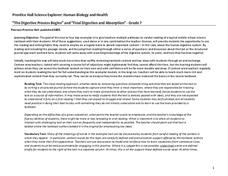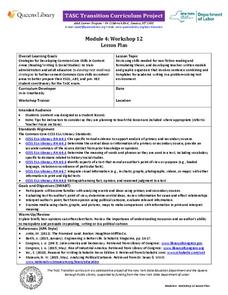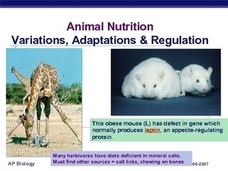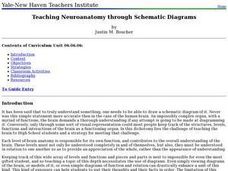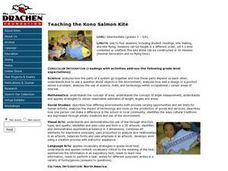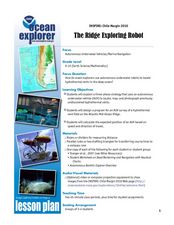Curated OER
Multiplication Strategies - A Day at the Zoo
This is an amazing 33-page resource for teaching multiplication! Your mathematicians will discover the connection between multiplication and repeated addition. They also will work collaboratively with arrays while studying zoo animals....
Savvas Learning
"The Digestive Process Begins" and "Final Digestion and Absorption"
Want your class to digest text more thoroughly? Middle schoolers learn about the digestive system in the lesson and reinforce informational text reading skills through a variety of strategies. They engage in a close reading...
Curated OER
Mayan Farming Practices
The introduction of this lesson requires reading a from The Maya by Jaqueline Dembar Greene. Learners sketch a Mayan during the reading. Teaching strategies include direct instruction, grouping the students for discussions, reasearch,...
Curated OER
Teaching Science to English Language Learners
Use these hands on lesson plans to make science more accessible for English Language Learners in your classroom.
Lerner Publishing
Teaching Habitats
What makes up a habitat? Use this resource to engage first graders in the exploration of desert, wetland, forest, and ocean habitats. Youngsters classify plants and animals into the four distinct habitats through drawings and cutting and...
Lerner Publishing
Meet the Dinosaurs
Take your class of youngsters on a prehistoric adventure with this four-lesson series on dinosaurs. Accompanying the Meet the Dinosaurs books by Don Lessem, these lessons engage children in writing their own dinosaur books,...
EngageNY
TASC Transition Curriculum: Workshop 12
How can opinions slant facts? Workshop participants learn how to examine primary and secondary sources and identify the author's point of view. They also examine how visual art impacts the meaning and rhetoric of sources. Full of...
Curated OER
Teaching Neuro-anatomy Through Schematic Diagrams
Students develop a deeper understanding of the brain. In this neuro-anatomyl lesson plan, students will use simple diagrams to understand the brain and will progress to more complex diagrams as they gain understanding.
Curated OER
Making and Using a Gel Person to Teach Human Anatomy
Students investigate organs, anatomical planes and transverse sections of the human body using gel people. In this human anatomy lesson plan, students use gel molds, gel and food items to make models of the human body. They create a...
Curated OER
Animal Nutrition - Variations, Adaptations, & Regulation
Colorful pictures and graphics make this a visually-appealing presentation on animal nutrition. Be aware that two of the sixteen slides include blank graphic organizers, so you will need to find the other existing version of this...
Curated OER
Teaching Neuroanatomy through Schematic Diagrams
Learners identify the parts and function of a neuron. They explain and illustrate the levels and functions of the nervous system including neurons and the Central and Peripheral Nervous Systems. They analyze and diagram the Lobes and...
Curated OER
Teaching the Kono Salmon Kite
Students complete several student readings involving kite making and kite flying. They analyze how the parts of a system go together and how these parts depend on each other. They comprehend how different environments both provide...
Curated OER
Teaching the Bell Tetrahedral Kite
Learners complete readings on kite making and kite flying. They analyze how the parts of a system interconnect and influence each other. Students identifies and uses color and form in a 3D artwork.
Curated OER
Architects of the Coral Reef
Students discuss reproduction in Cnidaria. in this coral reef lesson, students describe five characteristics of Cnidaria and compare and contrast the four classes. They describe the reproduction strategies they use.
Curated OER
The Robot Archaeologist
Students discover what is needed to program an underwater robot to complete a course of action. In this robot archaeologist lesson students design an archaeological strategy of an underwater vehicle.
Curated OER
How To Rule Cell Division
Learners explore cell division through auditory, visual and tactile stations that each describe a stage of cell division. Then they apply the information from the stations in a mini-homework project that is tailored to one of the...
Curated OER
A Peek at the Past: Gradualism vs. Punctuated Equilibria
Learners consider two sets of simulated fossils (caminalcules) that are provided as cutouts. They arrange them on two time scales. One set produces a visual example of gradualism, the other shows punctuated equilibria.
Curated OER
Teaching the Tr'panier Trapezoid Kite
Pupils analyze how the parts of a system go together and how these parts depend on each other. They comprehend the forces in terms of strength and direction. Students observe, measure and describe weather indicators.
Curated OER
A Reef of Your Own
Students study the reproductive strategies of reef building corals. In this coral reef lesson plan students describe the behaviors of reef building corals and their nutritional strategies.
Curated OER
A Reef of Your Own
Students research and study the life and reproductive strategies of reef building corals. They examine how coral reefs can produce high levels of biological material when they are surviving in areas of low nutrition.
Curated OER
The Ridge Exploring Robot
High schoolers study about an autonomous underwater vehicle and explain the strategies that it uses to locate and map hydrothermal vents. In this marine navigation lesson students design a program for an AUV survey.
Curated OER
Science: Flight Aerodynamics
Students apply the principles of aerodynamics by constructing styrofoam airplanes. By using simple tools and materials, they improve their spatial visualization abilities while increasing motor skills. After small groups of students...
Curated OER
Tropical Herpefauna
Young scholars explore tropical herpefauna. They discuss the story "Tropical Herpefauna...Tropical What?" by Lori Bruckeim. Students discuss any concepts of the essay that need clarification and they predict, visualize, question, and...
Curated OER
Worm Posters Presentations and Worm Box Part 2
Students work in small groups to investigate the topic, make a visual aid, and present to the class. They are given the following four topics: Worms and other decomposers, taking care of a worm box, waster and recycling, and...

